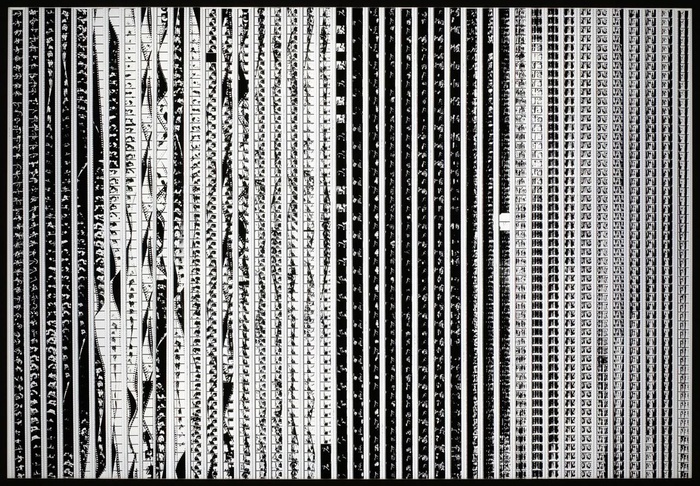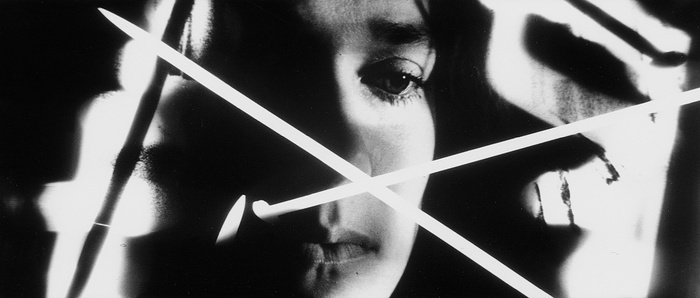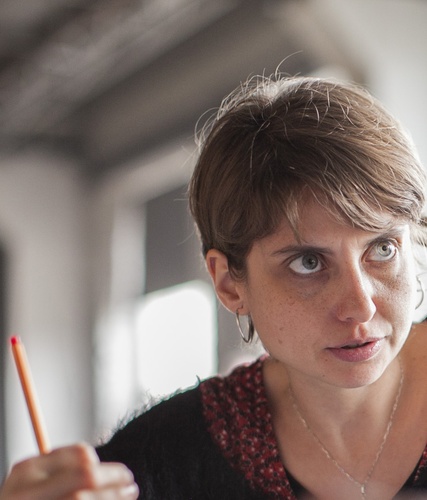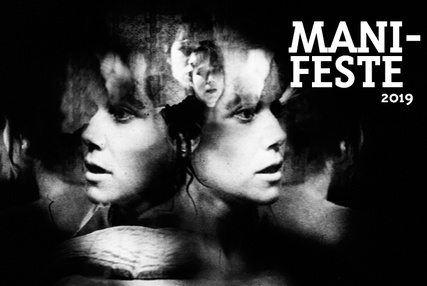Création musicale autour de Dream Work
Un projet européen
C’est un projet d’envergure européenne qui est à l’origine de la présence d’Ariadna Alsina dans les studios de l’Ircam cette année : initié par l’Académie Impuls de Graz dans le cadre d’ULYSSES, ce réseau européen qui réunit diverses institutions, festivals et ensembles dédiés à la diffusion de la musique contemporaine (dont l’Ircam), ce projet précisément réunit huit jeunes compositeurs autour de l’œuvre de l’autrichien Peter Tscherkassky. Objectif : composer des musiques pour l’un des deux plus célèbres films du cinéaste expérimental : Outer Space (1999) et Dream Work (2001), les deuxième et troisième volets du triptyque Cinemascope, réalisé à partir des images de L’emprise (1981), un film d’horreur hollywoodien. Lesquelles seront interprétées lors d’un ciné concert par l’Ensemble Nikel.
Au cours d’un atelier-symposium organisé en février 2017, les huit compositeurs ont pu rencontrer Tscherkassky et échanger avec lui sur son univers et ses méthodes de travail. Ils ont également pu converser avec divers spécialistes du sujet (dont le compositeur Wolfgang Mitterrer), avant de se lancer dans le travail lui-même. Sélectionnée avec Javier Elipe Gimeno par l’Ircam pour participer au projet, Ariadna Alsina a porté son dévolu sur Dreamwork (2001).
Bande annonce de Dream Work
« C’est d’abord cet univers de rêve/cauchemar qui m’a attirée, dit-elle, et l’entrecroisement entre rêve et réalité dans lequel le film nous perd. Auxquels s’ajoute la main du cinéaste qu’il met en scène en train de manipuler et couper la pellicule avec des ciseaux – comme s’il manipulait les rêves de la protagoniste du film. Il réalise en outre un véritable travail de superposition de différents « espaces » dans l’image. D’ailleurs, la théorie freudienne sur l’interprétation des rêves, évoquée par Tscherkassky à Graz, m’a servi dans l’analyse préliminaire du film que j’ai faite avant de me lancer dans la composition proprement dite : notamment pour toutes ces questions de condensation de couches filmiques et d’éléments qui peuvent recouvrir plusieurs pensées latentes, comme on en fait l’expérience dans l’élaboration des rêves. De même, les concepts freudiens de condensation et de déplacement m’ont en partie inspiré le traitement du matériau. »
Un projet artistique
« Mes premières idées musicales m’ont été inspirées par la densité des événements, l’empilement des couches, et puis les textures de Dreamwork… Peter a de surcroît introduit dans son travail des éléments extérieurs au film originel, dans un hommage à Man Ray : des punaises, des aiguilles, du sel… Jetés sur la pellicule manipulée, ces objets produisent toute sorte d’images abstraites. Toute cette matière m’a séduite et j’ai d’abord pensé pouvoir établir des correspondances entre ces textures et mon travail du son – en associant certaines formes et matières des objets à des caractéristiques spectro-morphologiques des sons, par exemple : aux punaises un son plutôt métallique et pointu, au sel des sonorités granulées et ainsi de suite. »
 Dream Work de Peter Tscherkassky
Dream Work de Peter Tscherkassky
« Très vite, toutefois, cette approche première s’est élargie, et le travail des textures et matières a évolué vers un travail sur la forme, notamment au moyen d’une analyse du film et de ses principaux tropismes, comme les dualités rêve/réalité, désir/violence… avec une catégorisation des univers, ambiances et gestes récurrents à l’écran. Ainsi de cette fenêtre devant laquelle pend l’anneau d’un store occultant, de ces visages et objets, ou de tous ces gestes de main qu’on voit à l’écran et qui m’ont donné des idées de gestes instrumentaux, pour leur répondre, soit immédiatement, soit en décalé : une main qui caresse une jambe, une main qui agresse et viole, et même la main du réalisateur qui coupe la pellicule… J’utilise aussi des extraits de la bande-son produite par les manipulations de Peter sur la pellicule : en effet, dans le cas des bobines de film classiques, les pistes sonores sont inscrites directement sur la pellicule, en marge de l’image (dans Dreamwork, on voit parfois la forme d’onde à l’écran !) : en découpant et remontant cette pellicule, une nouvelle bande-son prend forme, très bruitée. »
« Tout cela m’a permis d’élaborer une forme, en fonction de la direction que Peter Tscherkassky imprime sur l’attention du spectateur – jusqu’à ménager un climax. Après quoi, si le film continue d’être très dense et agité, la musique divergeant alors vers un autre chemin. »
Enjeux technologiques
Ou comment reproduire l’esprit sans la lettre. Si l’un des enjeux techniques à première vue évident d’un ciné-concert, la synchronisation image/son, est ici simplement escamoté par l’usage d’un simple clic-track (les musiciens ont une oreillette dans laquelle sont diffusés des repères temporels d’écoulement du film), les outils technologiques (de nature numérique) utilisées par Ariadna Alsina sont bien éloignés du travail manuel effectué par Peter Tscherkassky sur la pellicule…
 Dream Work de Peter Tscherkassky
Dream Work de Peter Tscherkassky
À commencer par certains procédés d’analyse d’image : « C’est Carlo Laurenzi, le réalisateur en informatique musicale qui m’accompagne, qui m’a proposé cette analyse des contrastes clairs/obscurs du film. Une analyse qui me sert moins à faire « coller » le son à l’image, qu’à générer un matériau sonore qui entretiendra un fort rapport avec le discours filmique : grâce à un générateur de bruits, j’obtiens des matières brutes que je retravaille ensuite pour obtenir des textures, qui peuvent annoncer, faire écho ou rappeler le passage filmique analysé. Je peux également utiliser ces données d’analyse pour gérer des séquences de synthèse concaténative, à partir de petits objets sonores pré-composés. »
« De manière générale, conclut la compositrice, j’essaie d’imprimer la qualité technique et gestuelle des images aux objets sonores que je compose. En outre, pour évoquer les fréquents passages du concret à l’abstrait, j’ai recours à de nombreux traitements et distorsions, appliquées à des sons instrumentaux – l’idée de combiner différents traitements sur une même source sonore ou de mélanger les sons instrumentaux avec des sons traités afin d’obtenir des sonorités hybrides. »
Projets précédents à l'Ircam
2016 –L’Air cassé de la carapace pour accordéon et électronique (pièce réalisée dans le cadre du Cursus I, encadré par Lorenzo Pagliei).
2017 – Le son au bout des doigts, création musicale avec Emmanuelle Lizère pour des installations interactives sonores et visuelles pour le jeune public.





